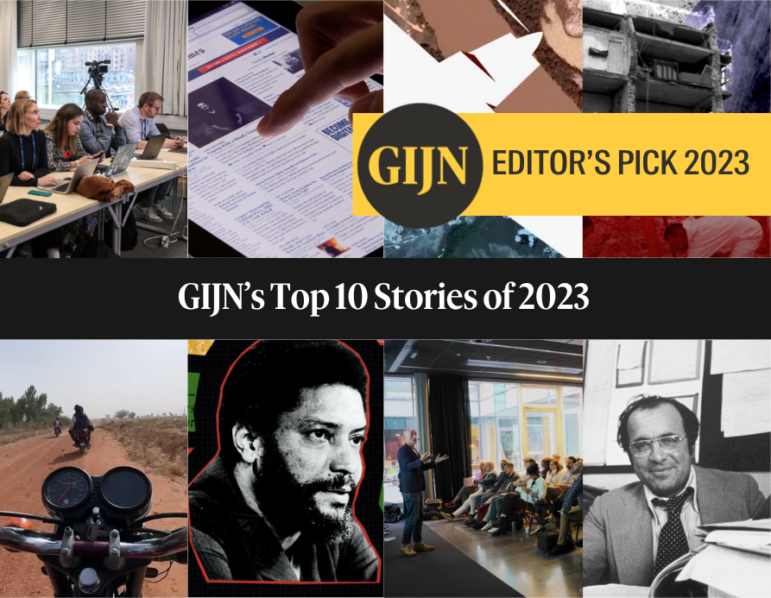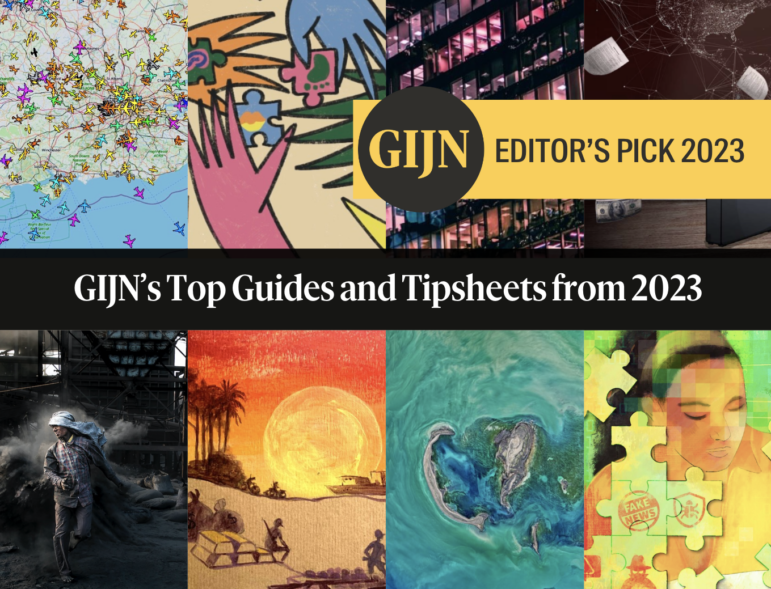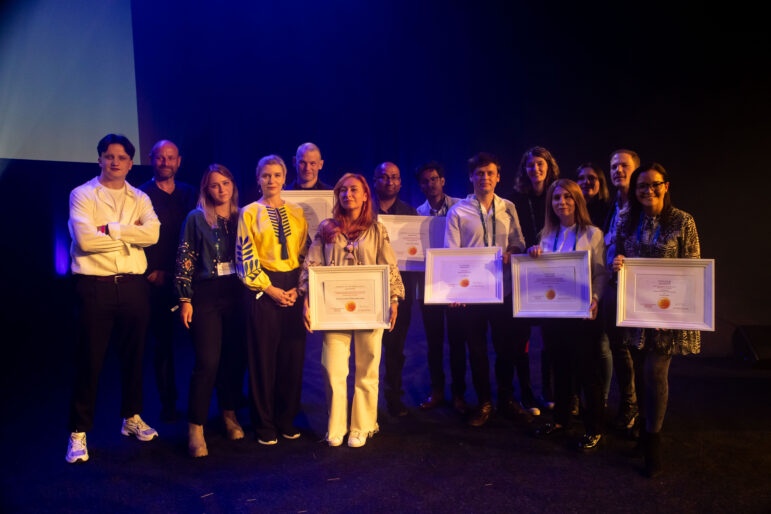

Image: GIJN
GIJN’s Top 10 Stories of 2023
GIJN’s original stories aim to inspire watchdog journalists around the world to pursue tough accountability issues, and to equip reporters with innovative techniques that worked in recent, real-world investigations.
They are also a great way to simply learn what’s on the minds of fellow investigative reporters, data journalists, and editors across the globe, who serve as the primary sources for the case studies, Q&A interviews, tipsheets, conference reports, toolbox stories, and case studies that appear on GIJN’s website every week.
In the list below, we’ve curated a short list of 10 notable GIJN articles from this past year — a mix of our most popular stories, great reads, game-changing reporting tips, and panel takeaways from the 13th Global Investigative Journalism Conference (#GIJC23) in Sweden that you might have missed.
The ‘Moonshot’ Newsroom: An Insider’s Account of the Meteoric Rise and Fall of BuzzFeed News Investigations
BuzzFeed News enjoyed a scintillating eight-year investigative run — while simultaneously inspiring reporters around the world — before a financial crunch shuttered this innovative watchdog division in April 2023. In this wonderfully readable, insightful, and sometimes humorous insider account for GIJN, former BuzzFeed News UK investigations correspondent Tom Warren describes the ingredients that led to the outlet’s journalistic triumphs — and ultimate commercial failure. The lessons offered are both fresh and clear for other watchdog newsrooms. Warren — a two-time Pulitzer finalist — highlights two underrated drivers of the most ambitious investigations: fun and friendship. He explains that the collaborative investigative unit — designed by Pulitzer-winner Mark Schoofs — was “half pirate ship and half family business, and it worked.” The team would “game out” potential blockbuster stories, and deadlines were determined “by when a story was finished.” The story includes detailed explainers on two award-winning projects. Warren explains how, sadly, too-rapid staff growth and a dependence on social media traffic contributed to the outlet’s demise. But read this story to rediscover why investigative journalism can be just plain cool.
Lessons Learned from Investigative Journalist Hayatte Abdou, from the Comoros
This year, GIJN’s 10 Questions series featured journalists and editors from challenging press environments such as Afghanistan, Nigeria, India, and Puerto Rico.

For GIJN’s 10 Questions series, GIJN Francophone editor Maxime Domegni interviewed Hayatte Abdou, who is among the few investigative journalists working in the small island nation of Comoros. Image: Courtesy of Abdou
One stand-out interview by GIJN Francophone Africa editor Maxime Domegni of Comoros-based National Magazine reporter Hayatte Abdou revealed rare insights about the challenges for women journalists investigating stories in a poor island nation. Hayatte Abou has produced courageous stories on the suspicious killing of fellow Comorien journalist Ali Abdou (no relation) and on corruption within the Comorien tax authority. Abdou describes the determination needed to overcome official push-back on stories — such as “Why do you want to stir all of that up?” and even “Why don’t you leave this kind of topic to your male colleagues?” She also supplied one of the best quotes of the year: “The day I go to prison, that will be an injustice, not because I’m an investigative journalist, but because I did my work so well.”
Bonus: For a gripping 10 Questions column that reads like a detective movie script, check out Laura Dixon’s interview with the wonderfully enterprising UK investigative journalist Raphael Rowe: From Tracking Blood Diamonds to Investigating a Wrongful Murder Conviction.
No Coding Required: A Step-by-Step Guide to Scraping Websites With Data Miner
This well-illustrated technical data story by GIJN Turkish editor Pınar Dağ emerged as one of GIJN’s most-read stories of 2023. And it is perhaps no coincidence that one of the more popular stories in 2022 — “Free, Game-Changing Data Extraction Tools that Require No Coding Skills” — was also a practical story on data scraping that required no technical coding. This speaks to the reality that only a small fraction of watchdog journalists have coding or even intermediate computer programming skills, but that a majority recognize the importance of getting available data into spreadsheets they can work with. Dağ’s story was also significant for editors because it lists the many reasons why data scraping is essential for many projects. Most importantly: this piece explains, point by point, how any reporter can use the free Data Miner browser extension to extract relevant information from websites, so reporters in under-resourced newsrooms can focus on the culprits and human impacts of the issue they’re probing.
Uğur Mumcu: The Foundation Continuing the Legacy of an Assassinated Turkish Investigative Reporter
GIJN’s member profiles explore the real-world successes and challenges of some of our 244 nonprofit member organizations, and offer useful insights on the investigation, distribution, and sustainability strategies that work for newsrooms with limited resources.
This piece by contributor Serdar Vardar describes the training success, inspirational origins, and impact legacy of Turkey’s um:ag — the Uğur Mumcu Investigative Journalism Foundation, named after the pioneering Turkish journalist Uğur Mumcu, who was assassinated in 1993. The organization does all this while facing a sharply deteriorating news media climate, in a country whose press freedom ranking has tumbled in the past decade, and where 90% of national media is government-controlled. The story includes compelling interviews with Mumcu’s daughter — um:ag co-founder Özge Mumcu — and investigative reporters whose careers and projects have been shaped by the courage of one reporter 30 years ago. Says Özge Mumcu: “They tried to silence him by taking his life, but with this foundation, we are keeping my father’s voice alive, and working to make it even louder.”
Audacious Tricks to Track Smuggled Goods, Identify Illegal Fish, and Interview Reluctant Sources
At every Global Investigative Journalism Conference, there are a few sessions that cause attendees to ask themselves “Can reporters really do that?” — and this story reflects one of these from GIJC23 in Sweden. If a fraudulent shell company refuses to list a physical address, why not send a letter to their post office box address with a GPS tracker inside? If a key potential source hates the media, why not send that person a bouquet of flowers, along with your phone number on an unsigned note? These were the kinds of “investigative hustle” tips offered by reporters from Mission Investigate — Sweden’s premier investigative TV program — who went on to explain how even posting YouTube video clips of bad actors swearing at journalists can boost impact for the core accountability story. This GIJN story explains the creative mindset journalists can employ to find other ways to get the information they need even if primary sources don’t work.
The 2023 Global Shining Light Award Finalists
There can be no brighter inspiration for investigative journalists than the example of under-resourced reporters who pull off scoops in perilous conditions.

A map featured in Corredor Furtivo, an ambitious data project by Armando.info on illegal mining in Venezuela, showing locations of illegal mines in red. Image: Screenshot, Armando.info
GIJN’s Global Shining Light Award (GSLA) recognizes journalists from developing or transitional countries who do exactly this, and our two round-up stories on the 12 finalists for 2023 featured summaries that could encourage newsrooms everywhere to tackle similarly tough subjects.
The Large Outlets round-up included an epic data project on illegal mining in Venezuela by Armando.info, an investigation into mass graves in eastern Ukraine by Radio Liberty/ Schemes, and a BBC Africa Eye revelation of hidden conflict in a Nigerian state, which was spearheaded by a courageous reporter who accessed warlords and victims via his motorcycle. The Small and Medium Outlets story included a blockbuster exposé by Cuestión Pública, which revealed collusion between police and private militia in the murder of 14 protesters in Colombia; an investigation into a secret prison in Dhaka, by exiled Bangladesh newsroom Netra News; and a dogged investigation into COVID-19 profiteering in North Macedonia by an all-women reporting team at the Investigative Reporting Lab.
Bonus: See our interview with one of the eventual GSLA winners — 27-year-old Nigerian journalist Yusuf Anka — on how he exposed armed gangs in northwestern Nigeria.
How They Did It: Tracking Phosphate Smuggling From Syria Into Europe
This story illustrates the power of three proven investigative techniques in combination: sticking with your investigative hunch; using open source ship tracking tools, and seeking collaboration with a better-resourced newsroom when you get stuck. Written by UK-based reporter Nader Durgham, this piece describes how Syrian Investigative Reporting for Accountability Journalism (SIRAJ) and its partners exposed a sanctions-busting scheme to export Syrian phosphate into European markets. Syrian journalist Mohammad Bassiki focused on phosphate mine contracts awarded to a company with a suspicious name — as well as ships with similarly hidden origins — and then partnered with the Organized Crime and Corruption Reporting Project (OCCRP) and the Netherlands-based Lighthouse Reports newsroom to confirm his hunch that the Syrian regime had found new routes for the export of these key chemicals. The piece noted: “The story was a finalist for the Daphne Caruana Galizia Prize for Journalism, and, a few weeks after the investigation was released, the UK and the EU expanded their sanctions on Syrian companies, including those involved in the trade of phosphates.”
Behind-the-Scenes of the Washington Post’s Investigation Into a 40-Year-Old Grenadian Mystery
In October, GIJN was honored to be offered a rare, first-look interview with the veteran leader of the iconic watchdog team at The Washington Post. While this piece focuses on an investigative podcast into the mystery of the disappearance of Grenada’s leaders in 1983, investigative chief Jeff Leen offers plenty of other tips for global investigative editors. Using the Grenada story as one of several examples, Leen provides detailed insights into the little-understood power of internal collaboration: the hidden value of the talent, personal contacts, and perspective of every contributor to a newsroom — from receptionist to newspaper delivery driver — and the importance of a wide-open invitation to anyone to share ideas with an investigations editor. Said Leen: “Investigative reporting is now woven through the entire newsroom, so everybody in every staff is looking for these types of stories, and when they find them, they bring them to us, and we build a team around them.”
Mastering the Rollout: Increasing the Impact of Your Investigative Story

A small New York newspaper uncovered suspicious claims by a US Congressional candidate, but they failed to get noticed before he was elected. Image: Screenshot, North Shore Leader
This story shows it is possible to break a story of seismic importance to your whole country, and still achieve zero impact.
This piece highlights a cautionary tale from the US to illustrate the importance of promoting investigations after publication, through social media, search engine optimization (SEO), and collaboration, and of connecting to audiences beyond your own. Written by GIJN social media editor Holly Pate, this piece details the steps needed to disseminate and amplify the scoops you find; to look at where your audience is interacting on social media; and to get your story in front of eyeballs, even if you’re reporting from exile. The story includes story packaging tips from the head of social media for Ukrainian investigative site Bihus.Info, and best practices for measuring success.
In a Hostile Climate, Guatemala’s Journalists Fear the Law Being Turned Against Them
The global rise in government harassment of independent journalists has been especially dire in Latin America, where intimidation by politicians and their allies sometimes includes the threat of kidnapping and assault. This well-sourced piece by Mexican journalist Raúl F. Pérez Lira describes the press freedom crisis in Guatemala, highlighted by the recent arrest and persecution of José Rubén Zamora, founder of Guatemala’s elPeriódico outlet. The story sets out the kind of multi-pronged tactics that have become a press intimidation playbook for autocrats, including advertising boycotts, spurious payback investigations, censorship, public smears, and politically motivated prosecutions. Alarmingly, Guatemala’s press freedom ranking has fallen by 50 places in 12 years — and Pérez Lira reports that there have been nearly 400 cases of journalist harassment under the current administration, “including the use of law to censor, criminalize, and obstruct the work of reporters.”
 Rowan Philp is GIJN’s senior reporter. He was formerly chief reporter for South Africa’s Sunday Times. As a foreign correspondent, he has reported on news, politics, corruption, and conflict from more than two dozen countries around the world.
Rowan Philp is GIJN’s senior reporter. He was formerly chief reporter for South Africa’s Sunday Times. As a foreign correspondent, he has reported on news, politics, corruption, and conflict from more than two dozen countries around the world.









